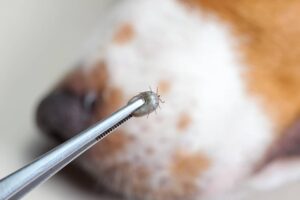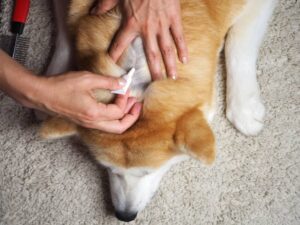Flea and Tick Prevention: Keeping Your Pets Safe
Every pet owner knows that the joys of owning a pet come with certain responsibilities. One of the most vital yet often overlooked tasks is ensuring our pets are free of fleas and ticks. Not only can these pests cause discomfort, but they can also transmit harmful diseases to both pets and humans.
In the UK, tick activity peaks from spring to autumn, primarily between March and October. Ticks love moist environments and are typically found in

grassy, wooded areas, and overgrown vegetation. This means places like your favourite walking paths, forests, or even your own garden can be hotspots for these pests.
What’s more, our beloved pets are curious creatures. Their penchant for exploring, playing in tall grasses, or venturing into the woods makes them prime targets for ticks.
In this blog post, we will delve deep into understanding these pests, the risks associated with them, and most importantly, how to effectively handle flea and tick prevention.
Read on to ensure your pets are protected year-round, especially during those peak tick seasons in the UK.
Understanding Fleas & Ticks
Understanding these pests is the first step to successful prevention.
Life cycle of fleas and ticks:
- Fleas: These tiny insects thrive in warm environments. Their life cycle – from egg to larvae, pupae, and adult – can span weeks to several months. While adult fleas are the ones causing discomfort to your pets, remember that most of the infestation exists in the environment in the form of eggs, larvae, and pupae.
- Ticks: Unlike fleas, ticks have a four-stage life cycle: egg, larva, nymph, and adult. In the UK, ticks become most active during warmer months, even more so when there is more moisture around so September is a prime month for ticks. The nymph and adult stages are the most likely to attach to our pets. The lifecycle can span years, with ticks feeding just a few times.
Health risks associated with flea and tick infestations:
- Diseases from ticks: In the UK, the most common tick-borne disease that can affect both humans and animals is Lyme disease. Pets may show symptoms like lameness, swollen joints, and fever. It’s essential to catch this early as Lyme disease can lead to severe health issues if left untreated.
- Fleas and diseases: While the direct bite of a flea can cause discomfort and itchiness, fleas are also carriers of tapeworm larvae. When a pet ingests a flea while grooming, they can become infected with tapeworms. Moreover, a substantial flea infestation can lead to anaemia, especially in young or frail animals.
- Allergic reactions: Some pets develop an allergy to flea saliva, leading to a skin condition called Flea Allergy Dermatitis (FAD). Signs include intense itching, redness, and inflammation. In severe cases, hair loss or infections can occur from excessive scratching.
Ticks and fleas aren’t just summer nuisances in the UK. Their presence and the risks they carry underscore the importance of year-round vigilance.
By gaining insights into their life cycles and the diseases they carry, we’re better equipped to protect our pets from these tiny yet formidable foes.
Preventive Measures
Now we understand the risks that ticks and fleas can pose to our pets protecting your pet is not just about their comfort; it’s about their overall health.
Thankfully, in the UK, we have a range of tried-and-tested preventive measures available:
Topical treatments:

Spot-on treatments: These are liquid treatments applied directly to the pet’s skin, usually between the shoulder blades or along the spine. They
provide protection against both fleas and ticks for up to a month. Examples include Frontline and Advantage. Ensure you choose one suitable for your pet’s size and weight.
Oral treatments:
Pills and chewables: These offer another line of defence against pests. Brands like Bravecto provide protection against fleas and ticks when administered orally. Some last as long as 12 weeks. While convenient and mess-free, some pets might exhibit side effects.
Collars, shampoos, and powders:
Collars: Flea and tick collars, such as the Seresto collar, release preventive ingredients over a prolonged period, offering long-lasting protection. Ensure it fits snugly with space for two fingers between the collar and your pet’s neck.
Shampoos and powders: While these might offer immediate relief from existing fleas, they don’t provide prolonged protection. They’re best used in conjunction with other preventive measures – for example, pills.
Environmental measures:
Home: Regularly wash your pet’s bedding in hot water and vacuum areas where they frequent. Consider using sprays if you suspect there’s an infestation.
Garden: Ticks thrive in long grass and dense vegetation. Keeping your lawn mowed and bushes trimmed reduces the chances of ticks finding their way onto your pets while at home in
Effective flea and tick prevention is about using a combination of measures tailored to your pet’s lifestyle and your environment. Always consult your vet about the best options and ensure products are UK-approved and suitable for your specific pet.
Tick and Flea Check Routine
Regular checks play a pivotal role in ensuring your pet remains free from these pests, particularly during the UK’s peak tick seasons.
Frequency of checks:
-
- Ticks: During warmer months (March to October), check your pets daily if they’ve been outdoors, especially in wooded or grassy areas where it would be common to find ticks.
- Fleas: Monthly checks are advisable year-round, but weekly checks might be necessary if your pet is prone to infestations if there’s been a recent outbreak in your area – or if your dog has encountered dogs with a known infestation.
Key spots to examine on your pet:
- Ticks: Focus on the head, neck, ears, and feet. However, ticks can latch onto any part of the body.
- Fleas: Look for flea dirt (black specks) in areas like the base of the tail, belly, and armpits. Using a fine-toothed comb can help detect them.
Safe removal of ticks:

- Use fine-tipped tweezers or a tick-removal tool. Grasp the tick as close to the skin’s surface as possible.
- Pull upward with steady, even pressure. After removal, clean the area with antiseptic.
- Dispose of the tick safely, ideally by placing it in alcohol, sealing it in a bag, or flushing it down the toilet.
Regular checks not only help in early detection but also reduce the risk of disease transmission. By incorporating them into your routine, you’re taking a proactive step in safeguarding your pet’s health.
What to do if your Pet is Infested
Even with preventive measures, infestations can sometimes occur.
Don’t panic; swift action can manage and eliminate the problem.
- Immediate steps to take:
- Isolate your pet: Keep them away from other animals to prevent the spread of fleas or ticks.
- Administer treatment: Use a recommended flea or tick treatment immediately. This might be a topical solution, shampoo, or oral medication.
- Consulting with a vet:
- Schedule an appointment to ensure your pet is in good health and hasn’t contracted any diseases.
- Your vet can offer advice on the best treatments and follow-up care.
- Treating your home and garden:
- Inside: Vacuum thoroughly, especially carpets, pet bedding, and soft furnishings. Consider using a household flea spray following the manufacturer’s guidelines.
- Outside: Keep grass short and clear away leaves. Insecticidal sprays can be used, but ensure they’re pet-friendly.
Conclusion:
The bond we share with our pets is a special one, built on love, trust, and care. Ensuring your pet is flea and tick prevention isn’t just about preventing itchy bites; it’s about safeguarding their health and well-being. As the UK moves through its warmer months, the threat of these pests looms larger. But armed with knowledge and vigilance, we can keep our furry friends safe and comfortable.
If you need some helpful advice or want to browse some tick and flea products be sure to contact us or call in at one of our local stores.
Always remember, that a happy pet leads to a happy home. Stay informed, stay proactive, and cherish every moment with your beloved companion.
Remember – if you’re ever unsure speak to your vet. They will be able to offer the best advice for YOUR pet.